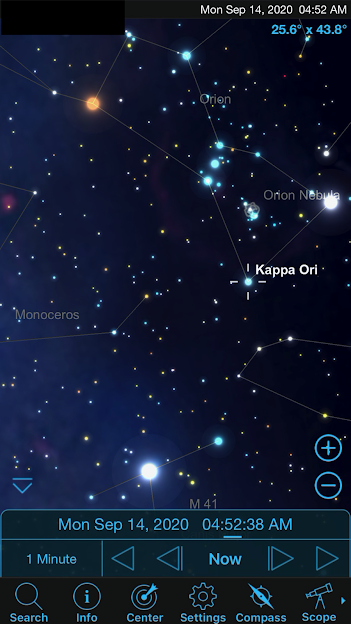Image Details
With Apple iPhone 6 Plus, 4.15mm f/2.2, 3264x2448 2mb, ISO 3712, 1/4 second exposure, taken with Nightcap app. The image is processed with Apple iMac to remove most light pollution noise. This is a determination of the photographic limiting magnitude given this particular sky, camera and app.
Determination of Limiting Magnitude under Taipei Light Polluted Skies
Sky Portal Comparison
Determination of Limiting Magnitude under Taipei Light Polluted Skies
Morning of Monday, September 14th, 4:37am
The planetarium program SkyPortal was used to screen capture at approximately the same time view at left and identify the dimmest star seen in the photo as 2.05 magnitude Kappa Orionis. Another star at 2.77 magnitude is seen near the Great Orion Nebula, still not enough to reach the Bortle 9 rating.
Visibility Limit
To the left of Kappa Orionis, and at the limit of visibility in the noise is a tiny spec, the star Gamma Monocerous at 3.98 magnitude.
Magnitude Matching
For stellar identification purposes, dial back the limiting magnitude of the planetarium program - in the second screen shot, the star magnitude is set to 4.4 to match the photo as best as possible.
Bortle Rating Insignificant
This is the limiting photographic magnitude of this particular image. The limit of the Bortle rating is 9, for naked eye objects detected at magnitude 4. However this sky has light pollution worse than Bortle 9 by another magnitude. The Bortle scale is useless for light pollution ratings in inner core cities.

OTIS Scale
I use the OTIS scale which uses a direct relationship with the visible star magnitude. A sky that shows only magnitude 3 stars is rated as a 3. As the number ratings become larger, for example 5, the sky becomes more clear with less light pollution. The OTIS scale allows rating the most light polluted inner core cities such as New York, San Francisco, Tokyo, Taipei, etc. and can go beyond first magnitude into negative magnitude numbers.

I use the OTIS scale which uses a direct relationship with the visible star magnitude. A sky that shows only magnitude 3 stars is rated as a 3. As the number ratings become larger, for example 5, the sky becomes more clear with less light pollution. The OTIS scale allows rating the most light polluted inner core cities such as New York, San Francisco, Tokyo, Taipei, etc. and can go beyond first magnitude into negative magnitude numbers.
Conclusion
This sky is precisely OTIS Scale 3.98 on the image. On this night, a maximum of twenty stars were visible within the Eastern patio sky window. With the advent of EAA and digital telescopes that can image in bright light sky pollution from the center of core cities, the Bortle Scale stops and reaches a limit where the OTIS Scale continues.

